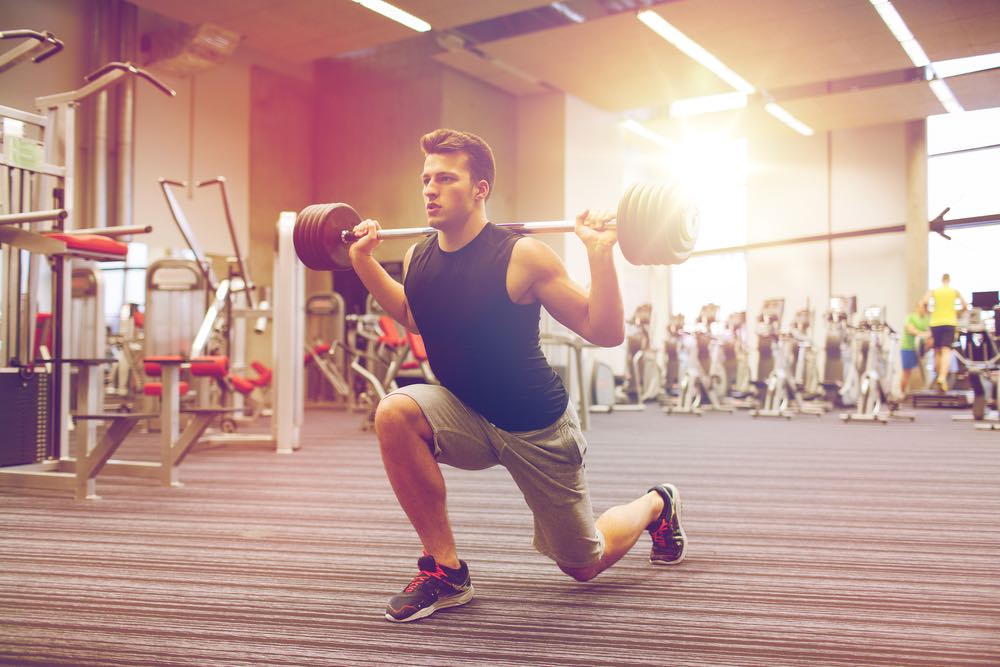Build strong and powerful legs with the barbell lunge
The barbell lunge isn’t just an exercise; it’s all-in-one lower-body size, strength and power builder. Hitting your quads, hamstrings, glutes and abs, while also improving balance, co-ordination and functional movement, this classic compound lift should be an essential component of any serious physique or performance training plan, says New Body Plan’s Joe Warner
Look around most busy gyms and there won’t be many men doing the barbell lunge. That’s because it’s a challenging compound lift that requires focus, control and co-ordination. But with big effort comes big rewards – especially if you want bigger, stronger and more powerful legs.
The move hits your quads, hamstrings, glutes, and even your core, making it a big-impact lift to work more than half your body in a single set. Read on to discover how to better incorporate this crucial exercise into your workouts to get the physique and performance improvements you want!
TL;DR The barbell lunge is a rewarding lower-body exercise offering a safe and effective way to train your hamstrings, quads, glutes and abdominals intensely. Ideal for beginners, it aids in mastering the lunge movement before progressing to other variants. And for more advanced lifters it provides the stimulus needed to maximise leg size, strength and power.
Find your perfect fat-loss plan!
Take the New Body quiz!
What is a barbell lunge?
The barbell lunge is a multi-joint exercise performed with a barbell positioned across your upper back. As a functional exercise, it mimics real-world movements, training multiple muscles simultaneously, which helps improve balance, coordination, and overall athletic performance. By challenging the muscles to stabilize the body under load, it enhances not only strength but also muscle endurance and symmetry.
What muscles does the barbell lunge work?
The barbell lunge is a compound exercise, meaning it works multiple muscle groups at once. Primary targets include the quadriceps, glutes, and hamstrings, with secondary engagement of the calves and core muscles. This total lower body engagement makes the barbell lunge an efficient and effective exercise for strength training and overall muscle development.
How do I perform a barbell lunge?
To perform a barbell lunge, start by standing with your feet shoulder-width apart and a barbell across your upper back. Keeping your chest up and your core engaged, step forward with one leg and lower your body down until your front thigh is parallel to the ground. Push back up to the starting position and repeat with the other leg. See below for a more detailed form guide, with set and rep suggestions.
Why should I do barbell lunges?
Incorporating the barbell lunge into your fitness routine comes with several benefits. First, it’s a compound exercise that works multiple muscles at once, leading to greater caloric expenditure and efficient muscle building. Second, the barbell lunge improves balance and stability, crucial for daily activities and sports performance. Lastly, it can help correct muscle imbalances and asymmetry, as each leg is forced to support the body’s weight independently.
What equipment do I need to do barbell lunges?
To perform the barbell lunge, you’ll need a barbell with an appropriate weight. The weight should be challenging enough to stimulate muscle growth without compromising form. Beginners may want to start with just the bar to master the movement before adding weight. A pair of good quality weightlifting shoes can also provide added stability.
What other moves are similar to the barbell lunge?
Several exercises engage similar muscle groups. These include the dumbbell lunge, split squat, Bulgarian split squat, and Smith machine lunge. While the muscle activation pattern may vary slightly among these exercises, they all require balance, coordination, and stability, making them excellent alternatives or complements to the main move.
Is the barbell lunge suitable for beginners?
Yes, but it’s crucial to master the correct form before adding weight. Beginners may start with bodyweight lunges and gradually progress to using a barbell as strength and stability improve. Proper form is key to preventing injury and ensuring the exercise effectively targets the intended muscle groups.
Can barbell lunges help improve sports performance?
Yes, barbell lunges can help improve sports performance by increasing lower body strength, balance, and stability. They can also improve explosive power and speed, which are important factors in many sports. Adding barbell lunges to your workout routine can help you perform better in activities that require lower body strength and endurance, such as running, jumping, or playing sports.
How to do the Zercher squat for strong legs, bigger biceps and six pack abs
How to do the barbell lunge
- Start by standing tall with a barbell resting on your upper back.
- Take a step forward with your right foot, lowering your body until your right knee is bent at 90 degrees and your left knee nearly touches the ground.
- Push off your right foot to return to the starting position.
- That’s one rep. Alternate leading legs with each rep, or do all the reps with one leg, then immediately do the same number of reps leading with your other leg.
How many reps should I do?
Aim for 3 sets of 8-12 reps per side.
How many sets should I do?
Do 3 to 4 sets, resting for between 1 and 3 minutes between sets.
How much weight should I lift?
Choose a weight that is challenging but allows you to maintain proper form for the desired number of reps and sets.
Barbell lunge progression exercise: Walking barbell lunge
Adding forward motion to the barbell lunge ups the challenge by increasing instability and further engaging the core.
Barbell lunge regression exercise: Bodyweight lunge
Removing the added weight of the barbell can help beginners master the movement pattern before progressing to weighted lunges.
Find your perfect fat-loss plan!
Take the New Body quiz!

